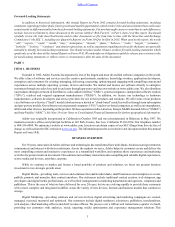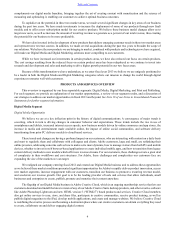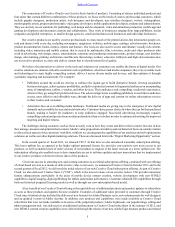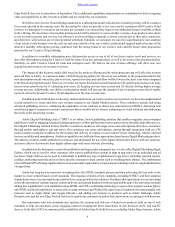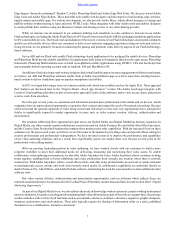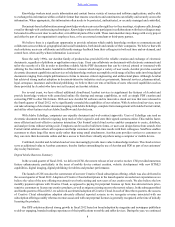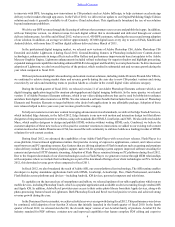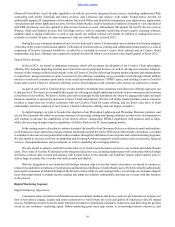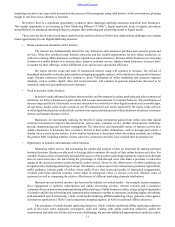Adobe 2012 Annual Report Download - page 12
Download and view the complete annual report
Please find page 12 of the 2012 Adobe annual report below. You can navigate through the pages in the report by either clicking on the pages listed below, or by using the keyword search tool below to find specific information within the annual report.
12
For example, businesses want to measure and understand the impact of their advertising initiatives across all these
channels, not only to determine how much credit should be given to a particular channel and to understand cross-
promotional effectiveness, but more importantly to optimize their advertising spending and make adjustments in the
way channels are utilized and align the amount of resources that are allocated to each of them.
• Delivery of premium video through online channels
Media companies face a shifting landscape as traditional media delivery evolves into multiple channels for
media companies to deliver and monetize their content. As more premium video content and entertainment is delivered
over the internet to PC, smartphone and tablet screens, as well as internet-connected TVs, media companies are looking
to create new revenue streams through subscription services and ad-based revenue models to supplement their historical
forms of revenue. This trend and the general explosion of video being created and delivered over the web is expanding
the online video market opportunity to include fast growing areas such as video delivery, authentication and
monetization.
To address the challenges and capitalize on the opportunities presented in the market trends above, CMOs, digital marketers,
advertisers and publishers require new content architectures, new analytic systems, new media buying systems and optimization
systems to increase the effectiveness of their engagement with customers.
Driving visitor traffic to websites, broadly defined as a customer's digital presence, including its traditional site, mobile
site, pages and apps on social networks, and all other content that is distributed throughout the internet, was an early goal of digital
marketing spend. This goal has broadened to include the need to measure and understand customer web traffic patterns and the
effectiveness of their visitor acquisition efforts. Web analytics solutions have provided insight for digital marketers and web
analysts that helps them optimize their online ad spending. Moving forward, the goals of digital marketers have evolved to include
how websites and marketing campaigns can convert visitors to customers, and how these websites and marketing campaigns can
be more personalized to drive better engagement and higher revenue.
Our Digital Marketing Business Unit targets this large and growing opportunity by providing comprehensive solutions that
include analytics, social, targeting, media optimization and experience management solutions, and premium video delivery and
monetization products, solutions and services. We deliver these capabilities through our Adobe Marketing Cloud, which is our
umbrella digital marketing offering and was formerly branded as the Adobe Digital Marketing Suite.
Adobe Marketing Cloud is a collection of analytics, social, targeting, media optimization and experience management
solutions and a real-time dashboard providing insight into the performance of online marketing initiatives. These capabilities
empower organizations to make informed decisions and ensure the success of online marketing programs for both advertisers and
publishers. Our digital marketing customers accomplish these goals with Adobe Marketing Cloud solutions which help them
manage and optimize online, offline, digital and multi-channel business initiatives.
Other key features of our Adobe Marketing Cloud include:
• Enabling digital marketers to align online marketing initiatives with overarching business objectives and demonstrate
the success of online marketing programs using metrics;
• Managing, collecting, and bringing data together from multiple systems into a flexible, integrated platform;
• Providing real-time business intelligence through segmentation, dashboards and reports that managers can use to gain
a complete picture of how consumers are interacting with the business;
• Creating the ability to monetize and share data through audience optimization capabilities, publishers can quickly
identify audiences that match the profiles that advertisers are demanding-and maximize the value of their digital assets;
• Optimizing ad spend by maximizing the impact of a company's advertising spend across and within channels, including
search, display, video, mobile, social media and other digitally connected forms of media, to yield the greatest returns;
• Delivering relevant and engaging digital content across channels that boosts key performance metrics, whether it is a
customer purchase, engagement, a download, form completion, or other desired outcome; and
• Empowering organizations to re-platform their websites by enabling them to create, manage, distribute, and monetize
content while optimizing the web, mobile, and social collaboration experience for their customers. More specifically,
organizations can enable the delivery of customer-facing web and mobile solutions by extending enterprise services
beyond interactive applications, documents, and workflows to include personalization of content, rich media delivery
Table of Contents



